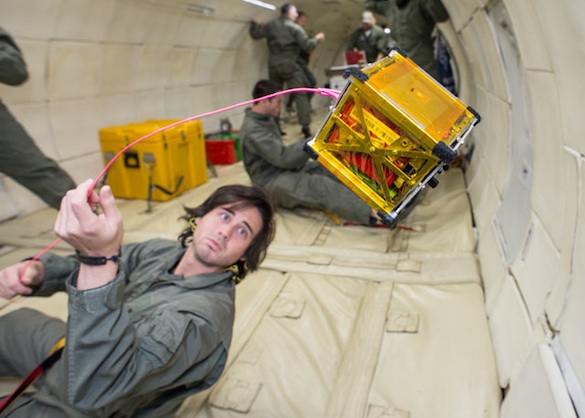Testing a CubeSat Attitude Control System in Microgravity Conditions
PI: E. Todd Bradley, University of Central Florida
PI: E. Todd Bradley, University of Central Florida

- TA02 In-Space Propulsion Technologies
- TA05 Communication and Navigation
We have constructed a Helmholtz coil testbed in order to demonstrate onboard control systems within the lab by suspending the cubesat within the field. We have completed an extensive set of experimental tests with this laboratory configuration; however, only single axis tests can be performed using our low cost ground-based testbed. In order to increase the Technology Readiness Level (TRL), we now need to extend our tests in two ways.
One is to test at least two-axis pointing capabilities of the prototype at any time in a microgravity (near zero-gravity) environment and two is to use the Earths magnetic field instead of the significantly amplified field produced by the Helmholtz coil. Near zero-gravity conditions from parabolic airplane flights can provide a perfect environment to test both of them where the cubesat is free to float during intervals of zero-gravity.
In the zero-gravity flight, our plan is to tether our prototype by a small chain to an Experimental Storage Unit (ESU) that is mounted to the floor of the aircraft. During takeoff and landing KnightCube will be stowed by strapping it to the ESU to prevent movement. When permission is given to proceed to the experiment we will un-strap KnightCube and await parabolic flight. During the first parabola we will enable power to the onboard systems, which will autonomously begin the control routines. The attitude control algorithm will calculate the current commands and drive the circuit to provide correct current through the magnetic coils mounted to KnightCube. During periods of zero-gravity we will release KnightCube and allow the control algorithms to function freely. When we begin to come out of zero gravity conditions we will restrain the prototype and await for the next cycle, where we will repeat similar experiments but with different attitude commands. We will not turn power off at any point. Batteries on board the KnightCube will last for at least 40 parabolas.KnightCube is self-contained in the sense that no external computer is required. The on-board subsystems consist of the flight computer, coils, batteries, inertial measurement unit, and the associated circuitry. A 152 cm tether chain, the ESU, and straps for stowing KnightCube to the ESU during takeoff and landing are also included external to the experiment.
Technology Details
-
Selection DateAFO6 (Jun 2013)
-
Program StatusCompleted
- 1 Parabolic
Development Team
-
PIE. Todd Bradley
-
Organization
-
SponsorUniversity of Central Florida
-
More Information

